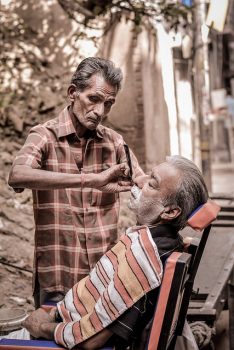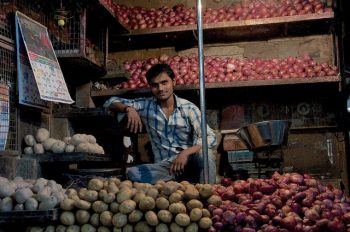Levels of Language: Register in Hindi, Part 2 Posted by Rachael on Dec 23, 2017 in Hindi Language, Uncategorized
In my last blog on the concept of “register” in Hindi, I discussed the more formal register of this language, which is heavily influenced by its “parent language” of sorts, Sanskrit. In this blog, I will delve into a more informal and colloquial register of Hindi: what is sometimes called “Hindustani.”
“Hindustani” is a quintessential celebration of Hindi’s “khichdri” (खिचड़ी, fem. noun) or mixed nature: it consists of a liberal mixture of Arabic and Persian-origin words, as well as those from Portuguese, Turkish and, less often, English, to name a few languages. This is the register used most often in daily life when interacting with others informally, such as while shopping for “sabzi” or vegetables (सब्ज़ी, fem. noun) in the bazaar (बाज़ार, masc. noun), while speaking to one’s rickshawallah (or “rickshaw driver”=रिक्शावाला, masc. noun) or while getting clothes custom made at a tailor’s shop (दर्ज़ी की दुकान/darzee ki dukaan, fem. noun). This register of Hindi is the “common denominator,” so to speak, amongst those who may not be highly educated in general and are much less educated in English than average and those who have perhaps attained more educational achievements, including schooling in English medium primary and secondary schools. In other words, this type of language can be understood by the greatest variety of people.
Here’s an example of this informal register in a conversation between a shopper and a sabzi seller (सब्ज़ी बेचनेवाला/sabzee bechnevaalaa or, simply, सब्ज़ीवाला/sabzeevaalaa):
खरीदनेवाला/khareednevaalaa (shopper): राम राम! क्या हाल है, रमेश भाई?
(Raam Raam! Kyaa haal hai, Ramesh bhaai?)
सब्ज़ी बेचनेवाला/sabzee bechnevaalaa (vegetable seller): अरे अनिल साहब, राम राम! ठीक हूँ मैं, और आप?
(Are Anil Saahab, Raam Raam! Thik huun main, aur aap?)
खरीदनेवाला: जिंदा हूँ, शिकायत करने की क्या बात? (chuckles) वैसे, मेरी बिवी ने मुझे बाज़ार सब्ज़ी खरीदने के लिए भेज दिया; क्या क्या ताज़ा है आज?
(Zindaa huun, shikaayat karne ki kyaa baat? Vaise, meri beevee ne mujhe baazaar sabzee khareedne ke liye bhej diyaa; kyaa kyaa taazaa hai aaj?)
सब्ज़ी बेचनेवाला: ख़ैर, ये बैंगन बहुत अच्छे लगते हैं आज और ये मटर । आलू और गोभी भी बहुत ताज़ा हैं । मैडम ने क्या क्या माँग लिया?
(Khair, ye baingan bahut acche lagte hain aaj aur ye matar. Aaloo aur gobhee bhi bahut taazaa hain. Maidam ne kyaa kyaa maang liyaa?)
खरीदनेवाला: उसने कुछ खास नहीं माँगा, बस कहा कि कुछ ताज़ा लाओ (chuckles again)। मेरे ख़्याल से, मैं दो-तीन बैंगन खरीद लूँ और आलू और गोभी भी, शायद वह कुछ आलू गोभी पका दे ।
(Usne kuch khaas nahin maangaa, bas kahaa ki kuch taazaa laao. Mere khyaal se, main do-teen baingan khareed loon aur aaloo aur gobhee bhi, shaayad voh kuch aaloo gobhi pakaa de).
सब्ज़ी बेचनेवाला: जी साहब, अच्छा चुना दिया आपने । मैडम को बहुत ही अच्छा लगेगा । मैं उन्हें पैक करके आता हूँ ।
(Jee saahab, accha chunaa diyaa aapne. Maidam ko bahut hi acchaa lagegaa. Main unhe pack karke aataa huun)
खरीदनेवाला: अच्छा, और कितने हुए ?
(acchaa, aur kitne hue?)
सब्ज़ी बेचनेवाला: पचास रुपए ।
(pachaas rupaye).
You will notice that certain words above were bolded. Here’s an explanation, word by word:
- खरीदना (khareednaa): to buy. A very common verb and the simplest way of conveying this idea. This word is designated as “Hindi” or “Hindustani” in the dictionary, meaning that it is more indigenous to the Prakrit (or so-called “lesser languages” native to the subcontinent, as compared with Sanskrit) languages that have influenced Hindi rather than a Sanskrit loanword. A certain Arabo-Persianate influence can also be detected with the less common use of the letter “ख़,” (as in “ख़रीदना”), which is a direct loan from Arabic and Persian, although most people in India now simply pronounce this as a hard (aspirated) “ख” or “kh.”
- हाल (haal, fem. noun): situation, circumstances, state, condition, etc. A very common and multipurpose word from Arabic that is an essential part of the beautifully simple “कया हाल है/kyaa haal hai?” or, literally, how is your situation/condition? as a way of inquiring how one is. A less common variant of this is “कया हाल चाल है?/kyaa haal chaal hai?” which means something like “how are you getting on?” or “how’s it going?”
- सबज़ी (sabzee, fem. noun): vegetable. From Persian, the most common word for “vegetable.” Another, less common variation is “तरकारी” (tarkaari, fem. noun), also from Persian, which can mean vegetables themselves or a curry made from them.
- साहब (saahab): Mr. or sir. This Arabic-derived word used to be very common, especially during the British Raj when it was de rigueur to refer to the male, British colonists as “साहब/saahab” and their wives and female relatives as “मेमसाहब/memsaahab.” Although it is less common now, it can be used conveniently as a way of addressing an unknown male who is older than you, as in “भाई साहब/bhaai saahab.” If you wish to address a younger, unknown male, “भैया/bhaiyaa” is your best bet.
- ज़िंदा (zindaa): alive. From Persian and related to the word “ज़िंदगी/zindagee” (fem. noun, life), this is a very common word that you should definitely keep handy in your mental lexicon.
- शिकायत (shikaayat, fem. noun): complaint or, combined with करना/karnaa, to complain. From Arabic and Persian.
- बीवी (beevee, fem. noun): wife. From Persian. The more formal, Sanskritized version of this word is पत्नी/patnee (fem. noun).
- ताज़ा (taazaa): fresh. From Persian.
- ख़ैर (khair): well, well then, in that case, I suppose, etc. A “filler” word from Arabic. Not common today but still somewhat useful.
- बैंगन (baingan, masc. noun): eggplant. From Dravidian languages (which encompasses most of the languages of Southern India, such as Tamil, Telugu, Kannada and Malayalam) with a hint of Prakrit thrown in. The mixed origin of this word hints at the mingling of cultures (and thus languages) instigated by trading networks.
- ख़ास (khaas): special, particular. From Arabic, a very common word.
- ख़याल (khayaal): thought, idea, opinion. Also from Arabic and sometimes spelled (and pronounced) “ख़्याल”/khyaal.
- मैडम, पैक (maidam, pack): “madame” and “to pack” (with the addition of करना/karnaa). In many ways, the more informal yet still respectful “मैडम/maidam” has replaced the more formal, colonial “मेमसाहब/memsaahab.” This is a common way of addressing a woman older than you to whom you wish to show respect or any woman (especially foreign) to whom you wish to show respect. To my chagrin, many people insisted on calling me “मैडम/maidam” when I was in India, most likely because of my foreignness. Another fun and convenient thing about “Hinglish” (or a combination of Hindi and English words, phrases, grammar and syntax) is that you can insert an English verb and follow it up with करना/karnaa (to do) in many different circumstances, such as in the fairly common पैक करना/pack karnaa (to pack something up, like food, in a box to go).
Lastly, a handy trick for detecting which words are of Arabic and Persian origin is that the following letters ONLY appear in loanwords from these languages, not from Sanskrit:
क़=q
ख़=kh
ग़=gh (a guttural “g”)
फ़=f
These letters were introduced into the Hindi syllabary, derived from that of Sanskrit, in order to approximate the pronunciation of these relatively new words from Arabic and Persian.
Quiz Time!
Test yourself. In order to claim any legitimate level of fluency in a language, you must master or at least attempt to master its various registers. Fill in the blanks of each sentence with the Sanskritized, formal register word as well as the informal, usually Arabo-Persianate word. Then check your answers with the answer key below:
- मेरे 1.____(father) चाहते हैं कि मैं 2.____(marriage) के बाद अपना काम जारी रखूँ । (mere _____ chaahte hain ki main _____ ke baad apnaa kaam jaari rakhuu)
- आज रात को मेरे 1.____ (husband) का 2._____ (family) खाने के लिए आयेगा । (aaj raat ko mere _____ kaa _____ khaane ke liye aayegaa)
- तुम कुछ 1._____ (special) पकाओगे आज? हाँ, मैं 2.____ (meat) बनाऊँगा, बहुत 3._____ (delicious) होगा ! (tum kuch _____ pakaaoge aaj? Haan, main _____ banaaungaa, bahut ______ hogaa)
- एक दिन वह अपने _____(friend) की एक _____ (book) पढ़ रहा था जब, अचानक, उसको उसमें एक _____ (love letter) मिल गया । (ek din voh apne _____ ki ek ______ parh rahaa thaa jab, achaanak, usko usme ek _____ mil gayaa)
- बहुत लोग कहते हैं कि नयी _____(language) सीखना बहुत ही _____ (difficult) है, लेकिन मेरे ____ में/से (opinion), _____ (benefit) कठिनाई से ज़यादा _____ (important) है । (bahut log kehte hain ki nayi ______ seekhnaa bahut hi ______ hai, lekin mere ______ me/se, ______ kathinaai se zyaadaa ______ hai)
Answers:
- 1) formal: पिता जी/pitaa ji (formal), informal: बाप/baap (use with care), पापा/paapaa, बाबा/baabaa, 2) formal: विवाह/vivaah, informal: शादी/shaadi, ब्याह/byaah.
- 1) formal: पति/patee, relatively informal: शौहर/shauhar, 2) relatively formal: परिवार/parivaar, informal: ख़ानदान/khaandaan.
- 1) formal: विशेष/vishesh, informal: ख़ास/khaas, 2) formal: माँस/maans, informal: गोश्त/gosht, 3) formal: स्वादिष्ट/स्वाद/svaadisht/svaad, informal: लज़ीज़/lazeez, मज़ेदार/mazedaar, मस्त/mast.
- 1) formal: मित्र/mitra, informal: दोस्त/dost, यार/yaar, 2) formal: पुस्तक/pustak, किताब/kitaab, 3) formal: प्रेम-पत्र/prem patra, informal: मोहब्बत ख़त/mohabbat khat.
- 1) formal: भाषा/bhaashaa, informal: ज़बान/zabaan, 2) formal: कठिन/kathin, informal: मुश्किल/mushkil, 3) formal: राय/raay, informal: ख़याल/khayaal, 4) formal: लाभ, informal: फ़ायदा, 5) formal: महत्वपूर्ण/mehetvapoorn, informal: ज़रूरी/zaroori, अहम/ahem.

Build vocabulary, practice pronunciation, and more with Transparent Language Online. Available anytime, anywhere, on any device.






